The presence of thermostats on heating system devices is currently not a luxury, but a necessity. In support of this, it is enough to give three reasons:
- The presence of thermostats allows you to constantly maintain a comfortable temperature in the room, and each room has its own;
- Installation of these devices allows you to get significant savings on heating costs, especially when it comes to a private house with an autonomous heating system;
- Installing a thermostat on a battery in an apartment located in an apartment building with a centralized heating system allows you to neutralize the significant temperature differences inherent in such systems.
Installation of thermostats on heating batteries begins with their selection and purchase.
When choosing them, it must be remembered that the following external factors influence the temperature change in the room: drafts, direct sunlight, changes in the outside air temperature, the presence of additional sources in the house that generate / absorb heat (electric heaters, pipes for cold and hot water supply, etc. .).
Any thermostat consists of a sensing element (thermal sensor or bellows) and a valve that operate without the need for external power supplies. A thermal sensor or thermal head is structurally made of a regulator, an actuator (liquid, gas or elastic) and a drive.
The decision on how to connect the thermostat to the radiator is made taking into account its design features.
Today, trade offers a very wide range of similar products, which are usually divided either by filler (liquid or gas-filled), or by the principle of operation (mechanical or electronic).
Installation of a thermostat of any type can be carried out on radiators in any heating systems. They can be easily adapted to work with existing radiator thermostats in new homes.
The principle of operation of mechanical thermostats is as follows: the required temperature is manually set on it. Installed at the inlet to the radiator, such a thermostat is triggered when the temperature rises, partially blocking the diameter of the inlet pipe, and when it decreases, increasing the latter, due to opening to the maximum value.
Electrically controlled regulators are subdivided into:
- Thermostats with built-in boiler heating control or circulation pump;
- Controls for a control valve installed at the radiator inlet.
Electronic thermostats (ET) have a remote or built-in room temperature control sensor, and operate on its signals. There are ET models with analog and digital control on the market. Moreover, the latter are increasingly replacing the former.
Digital ETs, in turn, are subdivided into open or closed logic. In the closed logic version, only certain parameters can be adjusted. Open logic allows you to freely program the thermostat for any parameters. These regulators, despite their clear advantage, are used much less frequently, since they require certain qualifications to operate them.
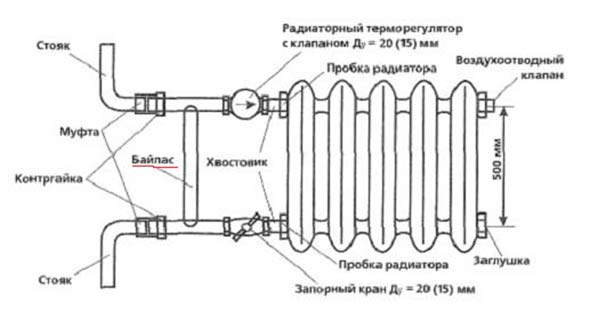
The generalized scheme of operation given below gives an answer to the question: "How to install a thermostat on a battery?" It looks like this:
- Before starting work, the corresponding CO riser (heating system) is turned off;
- The coolant descends from it;
- The existing horizontal piping to the radiator is cut off;
- The cut off part of the pipeline and the valve, if one has been installed, are disconnected from the radiator;
- The shanks (together with the nuts) are disconnected from the shut-off valve and the thermostat valve and screwed into the plugs on the radiator;
- The piping is reassembled and then installed in a pre-selected location;
- The installed piping is connected to the horizontal piping on the riser. For these purposes, couplings and konnuts are used.
The thermostat is installed on the radiator either on the radiator itself, or on a horizontal section of the inlet pipeline, close to it. If the radiator is covered by any interior items, then for its normal operation it is required to install an ET with a remote sensor for controlling the temperature in the room.
The procedure for installing the thermostat on heating batteries
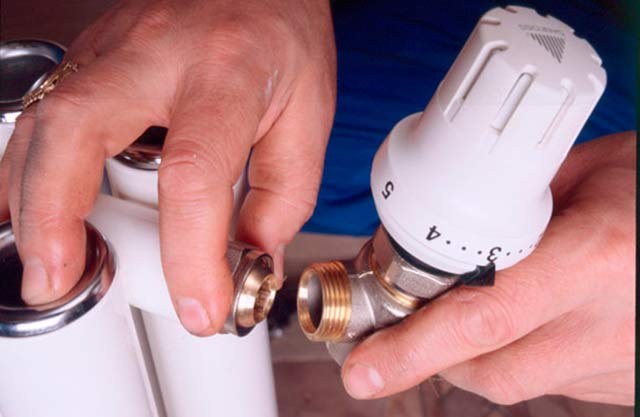
The installation of the thermostat is carried out directly into the hole in the radiator plug, along the flow of the coolant into it. At the same time, attention is drawn to the strict horizontal installation. This allows you to maximally compensate for the effect of heating the pipe and valve on its operation. If a one-pipe heating system is installed in your house, then the thermostat connection diagram must provide for the mandatory presence of a bypass. This is the name of the pipe bulkhead, which ensures the independent movement of the coolant in CO from the pipes through which hot water is supplied to the radiator.
If you install thermostats in a private house with more than one floor, then they should be installed from the upper rooms.
Features of installation and adjustment of the temperature controller
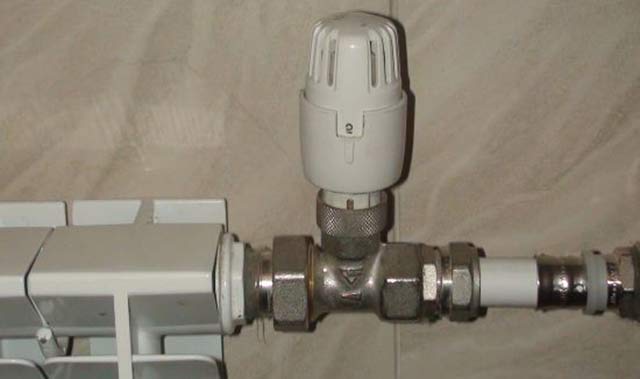
- ET should not be placed in the zone of warm air ascending over a working radiator;
- The thermostat connection diagram provides that it must be raised above the floor level by at least 800 mm;
- It must be protected from direct sunlight;
- The remote sensor, if available, must be rigidly fixed to the wall;
- Do not block access to the thermostat with furniture or curtains of heat flows that form in the room.
After the end of the heating season, the thermostat should be switched to the maximum flow mode (open), in order to avoid the formation of deposits on the valve seat.
Nowadays, at least a valve must be installed in the heating system to regulate the flow of heat that enters the radiator. This will not only provide comfort, but also protect. This means that the regulating part is necessary. Just what to install: a ball valve or a cone valve, or maybe an automatic thermostat? Let's see what types of thermostats are.
A ball valve alone will not cope, since it will either completely shut off the system, or it is open. You can, of course, turn the tap handle between these 2 positions, but this will lead to depressurization of the system.
The cone valve for the radiator will be more convenient, at any time, if you wish, you can close the valve on the radiator. The disadvantage of such a device is that you need to remember to return the valve to its original position. During the day, the sun came out through the window and diminished hot, in the evening I forgot to turn the valve - and froze at night. Therefore, the issue of rebuilding your heating system should be taken seriously so that everything works like a clock.
What are radiator thermostats?
A thermostat for a radiator is a device that controls the air temperature in a room to achieve the desired temperature regime. In a room that is heated, there is a natural heat exchange between the air and the heating system. As a result, the room temperature drops or rises. For best comfort and rational use of energy in heating systems it is necessary to monitor the amount of heat coming from heating devices. Installing a thermostat on a radiator will easily solve all these problems.
They fit well into any interior, are ergonomically designed and easy to customize. Thermostats can be installed in any heating system. They have a long service life and do not require additional maintenance. When using thermostats, there is no need to regulate the air temperature by opening windows.
Thermostats constantly maintain the set temperature (from 6 to 26 degrees), changing the amount of hot water passing through the heater and its heat transfer without using electrical or other external energy. To adjust the thermostat, turn the knob until the markings on it align with the arrow. The marks on the scale correspond to temperatures: I (1) -14 degrees, II (2) - 17, III (3) -20 and IV (4) -26.
The thermostat eliminates the supply of excess heat when necessary, thereby preventing overheating of the room and ensures a comfortable air temperature in it. In addition to all this, if you have an individual residential building, a thermostat in a boiler room will save about 20% of thermal energy for heating your home.
In urban environments, installing a thermostat on a heating radiator will help create comfort. Many people believe that it is most important to put it in the bedroom, but first of all, a thermostat is needed where there is additional heat: in the kitchen, in a room on the sunny side, in rooms where a lot of people gather.
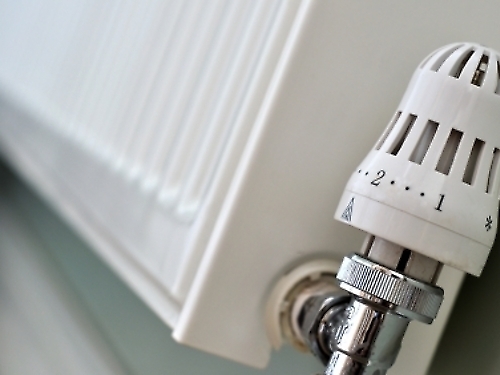
In private houses, radiator thermostats are installed, first of all, on the upper floors, since everyone knows that warm air is lighter than cold air, and it rises, so it is usually cool on the first floor, while on the second it is very stuffy ...
What are the thermostats?
On the modern market, consumers are presented with two types of thermostats - liquid and gas-filled. In gas-filled radiator thermostats, the gas always condenses in the cooler part of the sensor, which is remote from the control valve body, which means that the water temperature will not affect the thermostat, and it will always react to changes in the room temperature.
It is believed that gas-filled thermostats react to changes in room temperature faster. And liquid ones more accurately and better transmit the consequence of this temperature change (change in pressure in the bellows) to the actuator. But no one will ever be able to determine which ones are better. The best is reliable, which means it is of high quality.
What does a thermostat for radiators consist of?
The thermostat for radiators consists of 2 parts - a thermostatic element and a valve. A thermostatic element is a device that has a sealed cylinder (bellows) filled with a working substance - a gas that reacts to changes in the air temperature in the room.
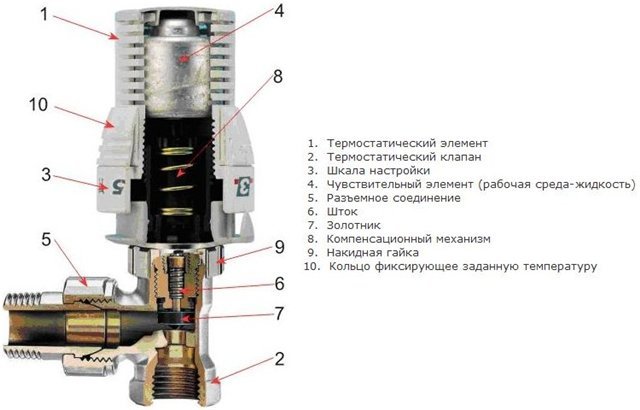
If the air temperature decreases, then the substance and the bellows are compressed, thereby increasing the flow of the coolant in the heating device. With warming, the substance in the volume increases, stretching the bellows, and the valve stem moves in the direction of reducing the heat flux flowing through the heat carrier heater. This continues until the balance between the gas pressure in the cylinder and the spring force is ensured.
Thermostat valve types
There are two types of thermostatic radiator valve: RTD-N and RTD-G. They also come in angular and straight versions. To select the type and size of the valve, you need to know the diameter of the hole in the stopper of the heater, the diameter of the pipe supplying water and the type of heating system.
The RTD-N valve is installed in two-pipe heating systems in new buildings, in cottages, if the circulating pump is running.
The RTD-G valve is installed in one-pipe heating systems of any buildings, as well as in two-pipe systems of old multi-storey buildings and cottages where there is no circulating pump.
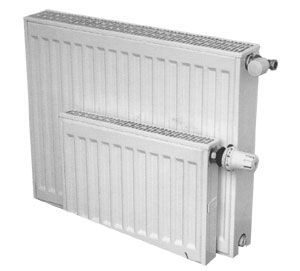
The valve is placed in the hole in the stopper of the heater on the side where hot water is supplied to it. It must be positioned so that the thermostatic element then remains in a horizontal position, in which the influence of the heat emanating from the pipe valve is completely excluded.
When installing the valve, it is necessary to clarify the direction of the water flow, as it must coincide with the direction of the arrow on the valve body.
There is a thermostatic element with a built-in sensor, which must be placed where the air around it will circulate freely, and with a remote sensor. To prevent the built-in sensor from heating up by the heat coming from the piping, it must be installed horizontally.
If the thermostat is in a niche or the thermostat is closed with curtains and the built-in sensor cannot respond correctly to the air temperature, then a thermostatic element with a remote sensor must be used.
How to install a thermostat sensor
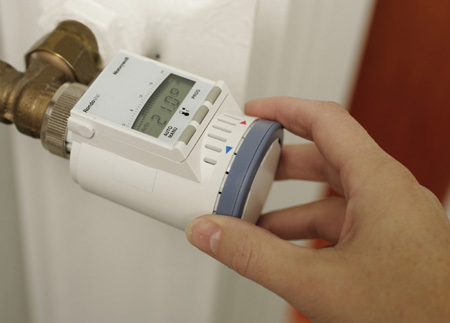
Many people install the sensor parallel to the plane of the radiator so that it is almost invisible, but this is not correct, since the warm air rising from the radiator affects the readings that the thermostat bellows is oriented to and an error in the instrument readings will occur. That's why it would be more correct to set it perpendicular.
Outcome
From all the above, we can safely say that thermostats for radiators are the way to a healthy microclimate in a house (apartment), to energy saving, and, of course, to financial savings. If you have a radiator thermostat installed, you can be sure that the required heat will be supplied to the room. Thanks to sensors, they regulate the supply of heat, taking into account weather changes and the selected temperature regime. By the way, you can select the mode separately for each room, which also plays a rather big role.
Find out what thermostats are for and what is the basic principle of their operation (video):
Here you will learn how an automatic thermostat can be used, as well as what some of the features of its use are.
When connecting the underfloor heating system, the room must be constantly maintained at the optimum temperature. To solve this issue, a thermostat for a warm floor is used in operation. You can not get around without it when the installation is carried out. This is an integral part of the operation of the entire system.
Concept
- By power. The device will not be able to fully work above the limit permissible load... You should carefully study this item during purchase and before connecting. V necessary cases they can be used in separate rooms to share the load. To prevent system overloads, a magnetic starter is additionally purchased, which creates a protective barrier in this direction.
- According to the installation option. When installing built-in thermostats, a hole is made in the wall. And overhead - a special box for installation is used, which is simply attached to the wall. A diagram is attached to each unit at the time of purchase. She should be guided during installation.
- System control with built-in or remote floor heating sensors.
- By the amount of functionality.
- By outward appearance etc.
Place of installation
There are practically no serious restrictions on where exactly to install the thermostat for. The main thing is that the temperature sensor for the warm floor is fully functional. There are only basic wishes. It is not recommended to mount them low, as it will make it difficult to manage them, create a program. A special place is occupied by wet rooms (bathroom, sauna), when the device can be located only outside of it, that is, outside. This will keep it in working order throughout its entire service life.
Almost all thermostats are leaky. With an increased level of humidity, they begin to work incorrectly, fail. They have no class of protection, which leads to the creation of certain conditions for safety.
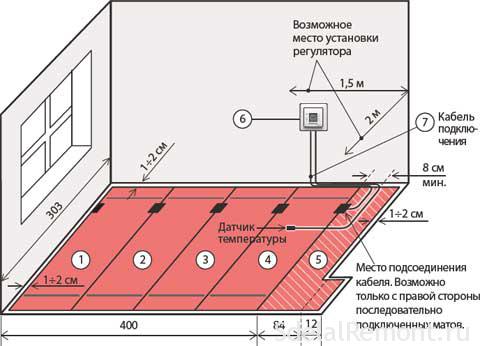 The savings start when the device is installed in adjacent rooms. You can install a two-zone thermostat that can control the temperature level in a single room. They will not carry any harm to each other.
The savings start when the device is installed in adjacent rooms. You can install a two-zone thermostat that can control the temperature level in a single room. They will not carry any harm to each other.
Connecting the thermostat to water heated floors
When used in work, the thermostat is presented in the form of a device capable of controlling a servo drive. It regulates the supply of the heat carrier to the heating places. Their control can be not only manual, but also electronic. Here, the underfloor heating thermostat sensor monitors the air temperature, not the floor temperature. Everything is connected with the high inertia of heating. The installation sequence is as follows:

In the process of work, various materials for underfloor heating can be used, among which fittings for underfloor heating are distinguished. During installation, turn off the circuit breaker for your own safety.
Connection to electric underfloor heating
Before starting work on the installation of the thermostat, you should competently and correctly arrange the electric floor heating itself. For this, all the preparatory measures are carried out, a heating cable or infrared film is laid. After that, the chosen one is made, after which the floor covering or other finishing surface is laid. Only then can you begin to set up and connect a thermostat for a warm floor strictly according to the points:
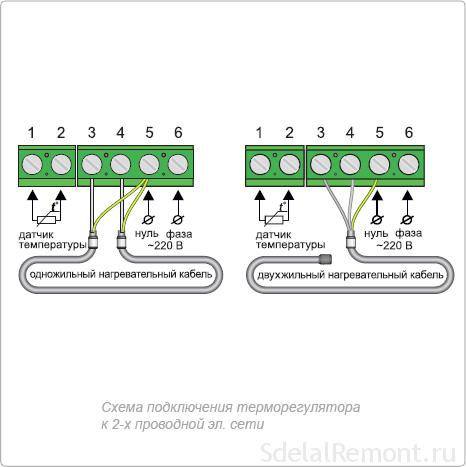
Right choice
When a floor heating thermostat is selected, it must perform the functions of not only connecting or disconnecting the power to the entire system, but also controlling the temperature level in the room. In this case, the switching power must be fully respected. Usually it is 3 kW.
When it comes to the air temperature level sensor, then you should be careful and careful. Heat can be affected by drafts, electrical and household appliances, air currents, and many other reasons.
The most popular are precisely electronic devices with floor sensors. They are distinguished by an acceptable cost of production, ease of use, and a high level of reliability during operation. In certain situations, sensors and instruments alone may be ineffective to operate and maintain. temperature regimes in room.
In any case, the installation of thermostats helps to reduce energy costs and financial investments. They pay off very quickly and are subsequently used for their intended purpose.
Video: thermostat for underfloor heating, overview and setting


